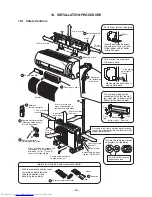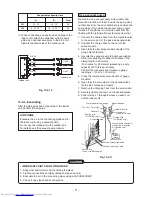
– 69 –
Fig. 10-5-2
Strong
wind
Precautions for adding refrigerant
• Use a scale having a precision with at least 10 g
per index line when adding the refrigerant.
Do not use a bathroom scale or similar instrument.
• Use liquid refrigerant when refilling the refrigerant.
Since the refrigerant is in liquid form, it can fill
quickly.
Therefore, perform the filling operation carefully
and insert the refrigerant gradually.
Precautions for adding refrigerant
• Use a scale having a precision with at least 10 g
per index line when adding the refrigerant.
Do not use a bathroom scale or similar instrument.
• Use liquid refrigerant when refilling the refrigerant.
Since the refrigerant is in liquid form, it can fill
quickly.
Therefore, perform the filling operation carefully
and insert the refrigerant gradually.
CAUTION
1. Install the outdoor unit without anything
blocking the discharging air.
2. When the outdoor unit is installed in a place
always exposed to strong winds like on the
coast or on a high story of a building, secure
the normal fan operation using a duct or a
wind shield.
3. Especially in windy areas, install the unit to
prevent the admission of wind.
4. Installation in the following places may result
in trouble.
Do not install the unit in such places.
• A place full of machine oil.
• A saline-place such as the coast.
• A place full of sulfide gas.
• A place where high-frequency waves are
likely to be generated, such as from audio
equipment, welders, and medical equipment.
Base plate
9 Drain
nipple
10 Water-proof rubber caps
(supplied with the outdoor unit)
10-5-2. Draining the Water
• Holes are provided on the base plate of the
outdoor unit to ensure that the defrost water
produced during heating operations is drained off
efficiently.
If a centralized drain is required when installing
the unit on a balcony or wall, follow the steps
below to drain off the water.
1. Proceed with water-proofing by installing the
water-proof rubber caps
in the 2 elongated
holes on the base plate of the outdoor unit.
[How to install the water-proof rubber caps]
1) Place four fingers into each cap, and insert
the caps into the water drain holes by push-
ing them into place from the underside of the
base plate.
2) Press down on the outer circumferences of
the caps to ensure that they have been
inserted tightly.
(Water leaks may result if the caps have not
been inserted properly, if their outer circum-
ferences lift up or the caps catch on or wedge
against something.)
Fig. 10-5-3
2. Install the drain nipple
and a commercially
available drain hose (with 16 mm inside diam-
eter), and drain off the water.
(For the position where the drain nipple
is
installed, refer to the installation diagram of the
indoor and outdoor units.)
• Check that the outdoor unit is horizontal, and
route the drain hose at a downward sloped
angle while ensuring that it is connected tautly.
Do not use ordinary garden hose, but one can
flatten and prevent water from draining.
Fig. 10-5-4
Commercially available
drain hose
Base plate
9 Drain
nipple
















































